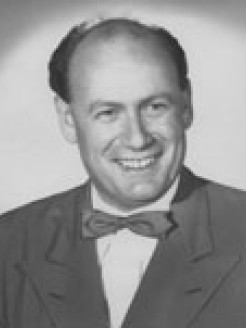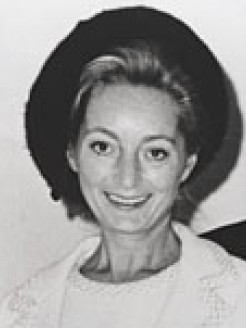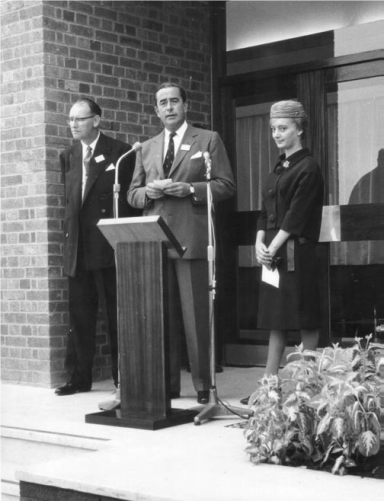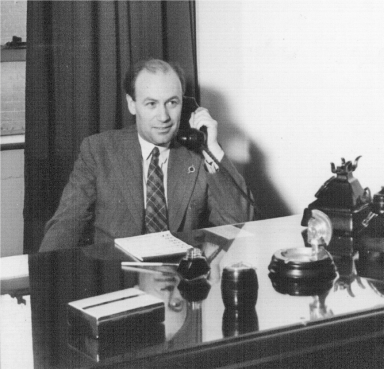
Our history
The Stanley Thomas Johnson Foundation looks back on a complex history. Historical research helps us to gain a better understanding of the foundation’s establishment and the motivation behind it. An investigation.Based on historical research and texts by Marcel Brengard & Peter Miles
The Founders
One thing is certain: the eponymous foundation carries the name of the British industrialist Stanley Thomas Johnson. Its establishment, however, cannot unequivocally be traced to him. It owes its existence to his wife, June Mary Johnson and his trustee Hugo Spühler. According to the latter’s own statement, it was he who persuaded the widow to leave the entire marital estate to a charitable foundation in her will. It stipulated that after her death the foundation should be set up in Bern and named after her deceased husband.
Stanley Thomas Johnson
b. 10.06.1910 d. 01.02.1967
Mary June Johnson
b. 28.03.1931 d. 07.04.1969
Rivets and Jet Set
Born in 1910 in the South of England, Stanley Thomas Johnson decided on a career in the automobile and aircraft industry 26 years later. Around this time he patented the Chobert blind rivet, which is still used for aircraft manufacture today. When World War II broke out in 1939 he built his main production facility outside London, manufacturing goods for the booming aircraft industry. Under the name Avdel (short for Aviation Developments) further factories were established all over the world. Stanley and June probably met in the early 1950s in London. In 1954 they married in California before moving to an apartment with a view of the lake in a high-end neighbourhood in Geneva. The couple travelled a lot and led a rather inconspicuous life in Switzerland. During this time, the left-wing Labour Party remodelled Britain into a welfare state and transferred many large companies to state ownership. It is possible that economic reasons persuaded the canny businessman Johnson to relocate to Switzerland.
Last Will?
Stanley Thomas Johnson died in 1967 at the age of only 57 following a long illness. In his will he left his entire estate to his wife June. The management of the estate, however, was entrusted to the so-called Avdel Policy Committee (APC), which he had appointed before his death. The APC consisted of three trusted associates of Avdel, three personal advisors and the secretary Elsie Metcalfe. This committee determined June Johnson’s finances to a large and often patronizing extent. She died in 1969, only two years after Stanley, in unexplained circumstances in her Geneva apartment. She was only 38 years old. Since June had lost her parents early in life and did not have children, CHF 100’000 of her estate went to Stanley’s sister. The rest of the assets were used to establish the Stanley Thomas Johnson Foundation in 1969. Metcalfe as well as Spühler always insisted that the foundation’s aim was to ensure the continuance of the Avdel Group in accordance with Stanley Thomas Johnson’s wishes. However, there are no documents confirming his intention to create a charitable foundation. Certainly, its establishment prevented a division of the estate and ensured the cohesion of the conglomerate and thus Johnson’s life work. It is therefore probably the preservation of the Avdel group that corresponded most closely to Johnson’s will.
Difficult Beginnings
Half a year after June Johnson’s death, the Stanley Thomas Johnson Foundation already held its first meeting. The majority of the board was made up of the Avdel Policy Committee (APC), supplemented by a few new faces with connections to members of the APC. According to June Johnson’s will, the foundation was intended to fund the promotion of art, music, theatre, international aid (especially by the IKRK) and disaster relief, as well as medical research. After two first rounds of funding, the acquisition and selection of further organisations qualifying for support proved complicated. The board members suggested suitable themes and projects and approached organisations directly for recommendations of projects worthy of support. Soon, however, a rapidly increasing number of applications were submitted to the foundation and the board was increasingly occupied with rejecting projects outside of the foundation’s remit. The first ten years of the foundation’s existence were also defined by managing the transfer of assets from June Johnson’s personal estate to the foundation’s control. The allocation of project funding took a back seat during this time.
The Sale
Over time, the APC increasingly perceived the ownership of the Avdel Works as a burden and found it difficult to reconcile the interests of the foundation and the company. In March 1973, the committee therefore decided to sell the Avdel Works if an appropriate offer could be agreed. However, in light of the growing world-wide recession, the company was to be transferred to the newly created company Avdel International N.V. (ANV). The APC members Pearson and Moore planned to acquire a third of it and then sell the entire conglomerate in an organized way. Hugo Spühler searched for an interested buyer, which he found in 1978 in the company Newman Industries. However, the sale of Avdel triggered considerable press attention. The Financial Times wrote in this context about “the mysterious S.T.J.F.” (the mysterious Stanley Thomas Johnson Foundation), because it was so little known. Mr Musitelli, the director of Avdel Paris, even filed a complaint to the supervisory board, claiming that Pearson and Moore had made unlawful profits through their acquisitions and that this amount should have gone to the foundation. In addition, he suggested that the concentration on one buyer did not result in an optimal price, meaning that the foundation board had acted contrary to the interests of the foundation. In a personal conversation, however, he was persuaded to withdraw his complaint. The sale enabled the foundation to secure its financial resources and simplify its administration. At the same time, it marked the end of the Avdel Policy Committee.
More Freedom
As a result of the sale there was much more money available for the foundation’s funding activity. From 1978 onwards, it therefore worked to make its mission better known to the public. In addition, experts were consulted to evaluate the applications. A further innovation was the introduction of supervision trips, which gave the foundation’s trustees the opportunity to examine the development and aid projects in situ and make progress reports. In the course of the 1980s, the foundation increasingly developed its full impact and financed more and more projects by various organisations. It was open to new approaches to charitable work. In the following years, it approved projects to provide therapeutic help to addicts or supported women's shelters and other facilities for victims of domestic violence. The foundation thus demonstrated sensitivity to current social problems and a commitment to reinterpreting the purpose of the foundation as laid down in June Johnson’s will and adapting the focus of its support.
A Grown-Up Foundation
Since the establishment of the foundation, a codicil had determined the allocation of funds, preventing the foundation from supporting projects in Soviet Russia or Germany, for example. In the late 1990s, these internal regulations appeared increasingly outdated in light of new federal racism laws and the end of the Cold War. The Swiss Federal Department of Home Affairs therefore had the codicil repealed. In 1999, the foundation hosted its 30th anniversary celebrations at the Kultur-Casino Bern. Tickets for public events cost CHF 20, and the concert by the well-known Bernese pianist Reto Reichenbach, attended by Federal Councillor Dreyfuss and other personalities from business and politics, was well attended. Unfortunately, Hugo Spühler – co-founder, secretary, chairman and later honorary president of the Stanley Thomas Johnson Foundation – did not live to see the festivities, as he passed away shortly before. Following the death of Elsie Metcalfe in 1994, the last member of the Board of Trustees who had known Mr. and Mrs. Johnson personally died with him.
Good Governance
The 2000s were marked not only by the financial crisis in the second half of the decade, but also by a donation to the foundation. This represented an important turning point in its history and resulted in a considerable reorientation of funding practice: for example, the donation added education to the support sectors of the foundation, which from then on financed scholarships and entire school projects in the Canton of Bern. Personnel changes also took place during this period and the board of trustees increasingly reflected its own activities. In workshops and in collaboration with external experts, it repeatedly examined the funding criteria as well as the foundation's activities in general and aligned itself with the concept of good governance. The board issued regulations for conflicts of interest, revised internal regulations, strengthened the role of experts, further expanded the committees and increased its public exposure. This included the introduction of the June Johnson Dance Prize. The foundation also sought collaboration with professional organizations whose expertise it could call upon when necessary.
Expertise and Half a Century
Following the spirit of expert engagement, the foundation’s board of trustees phased out support for individual medical research projects in 2013 and instead initiated a sustained collaboration with the Swiss Academy of Medical Sciences from 2014 - 2018. In the area of education the pilot project “2nd Chance for a 1st Education” was launched in 2016. In collaboration with the Department of Health and Welfare and the Department of Education of the Canton of Berne, this project offers selected people the opportunity to complete initial vocational qualifications. From 2019 onwards the foundation is also supporting two projects for the health management of refugees by the Swiss Tropical and Public Health Institute. In the same year, it celebrates its 50th anniversary.





